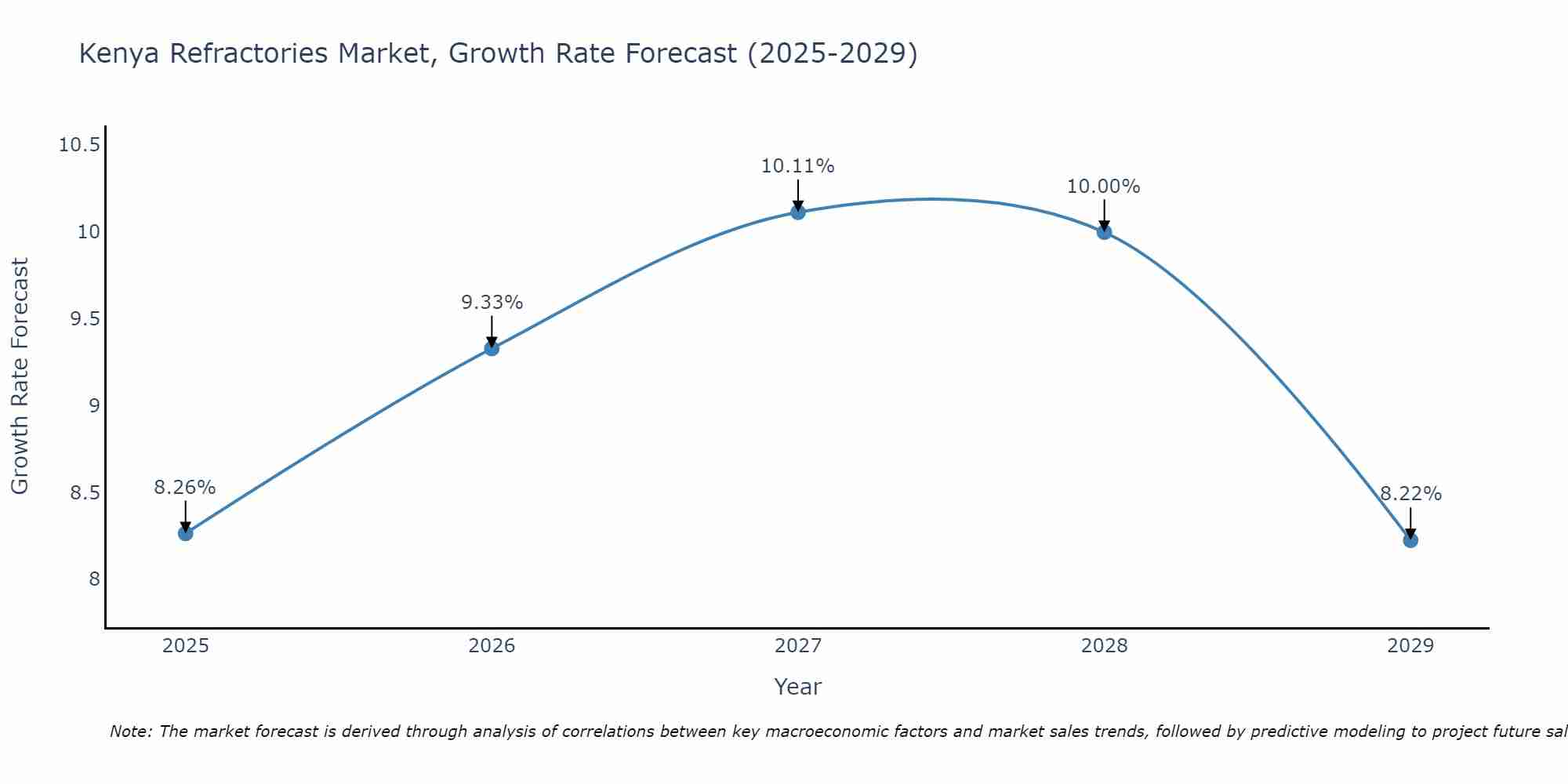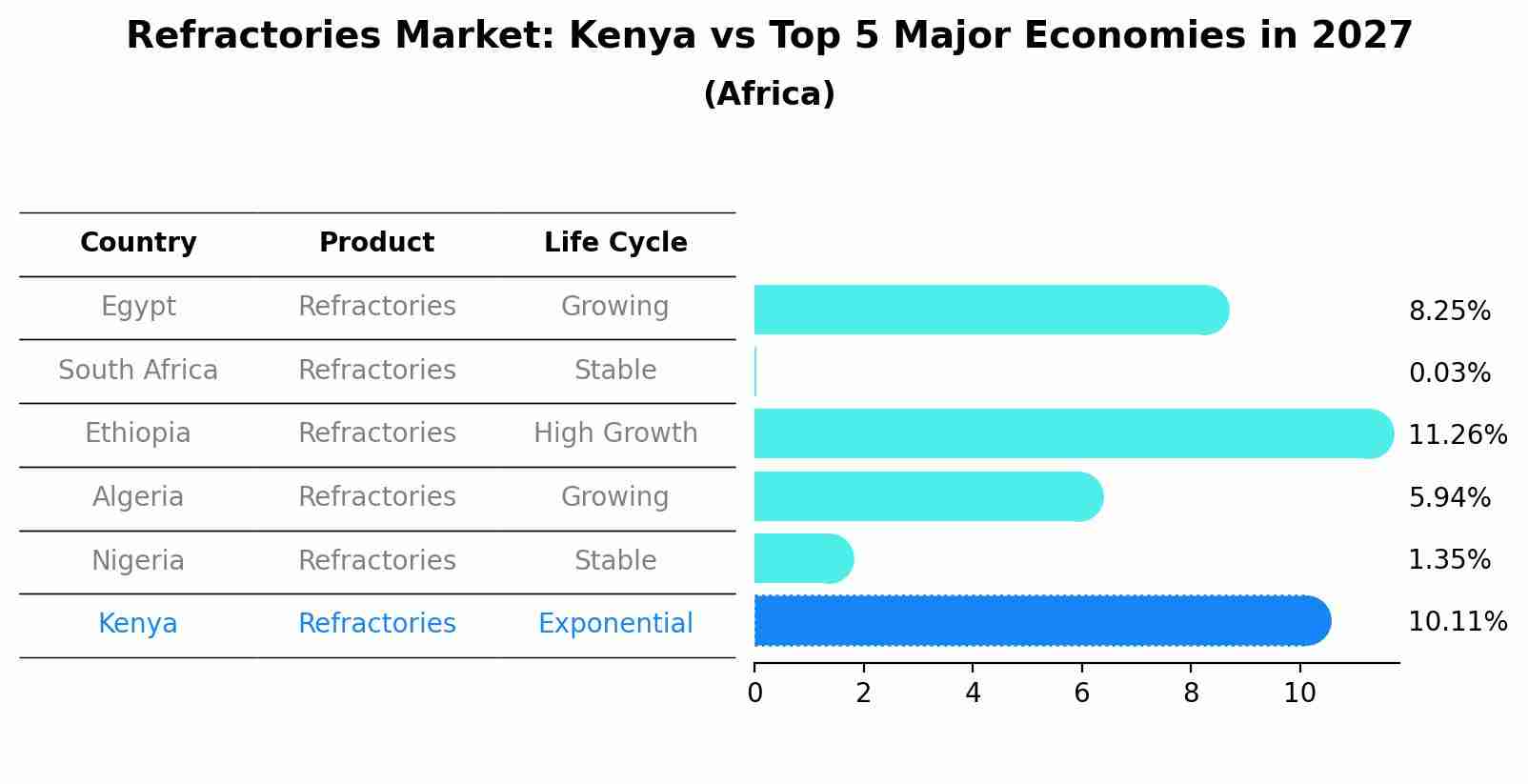Kenya Refractories Market (2020-2026) | Share, Forecast, Analysis, Size, Value, Companies, Industry, Trends, Growth, Revenue, Outlook & COVID-19 IMPACT
| Product Code: ETC008710 | Publication Date: Oct 2020 | Updated Date: Apr 2025 | Product Type: Report | |
| Publisher: 6Wresearch | No. of Pages: 70 | No. of Figures: 35 | No. of Tables: 5 | |
Kenya Refractories Market Size Growth Rate
The Kenya Refractories Market is projected to witness mixed growth rate patterns during 2025 to 2029. Growth accelerates to 10.11% in 2027, following an initial rate of 8.26%, before easing to 8.22% at the end of the period.

Refractories Market: Kenya vs Top 5 Major Economies in 2027 (Africa)
The Refractories market in Kenya is projected to grow at a high growth rate of 10.11% by 2027, highlighting the country's increasing focus on advanced technologies within the Africa region, where Egypt holds the dominant position, followed closely by South Africa, Ethiopia, Algeria and Nigeria, shaping overall regional demand.

Kenya Refractories Market Overview
The refractories market in Kenya is growing, driven by demand from the steel, cement, and glass industries. Refractories are essential for withstanding high temperatures in industrial processes, such as furnaces and kilns. The market`s growth is supported by infrastructural developments and increasing investments in manufacturing facilities. Key trends include the adoption of advanced refractory materials to improve efficiency and reduce energy consumption.
Drivers of the market
The Kenya refractories market is driven by the growth in the construction, steel, and cement industries. Refractories are essential for high-temperature industrial processes, influencing market demand alongside infrastructure development projects.
Challenges of the market
The refractories market in Kenya faces challenges such as the high cost of raw materials, dependency on imports, and fluctuations in demand from key sectors such as steel and cement. These factors impact market stability and the ability of local refractory manufacturers to compete with international suppliers.
Government Policy of the market
The Kenya government has formulated policies to regulate and promote the refractories market, recognizing its importance in supporting industrial sectors such as steel, cement, and ceramics. Regulatory measures include quality standards and technical specifications to ensure the performance and durability of refractory materials. Additionally, the government supports local manufacturing of refractories through tax incentives and investment in research and development. These initiatives aim to reduce import dependency and create employment opportunities in the refractories sector. Moreover, the government collaborates with industry stakeholders to promote innovation and best practices in refractory manufacturing. This integrated approach is part of Kenya strategy to enhance its industrial capabilities and support sustainable economic growth through value-added manufacturing.
Key Highlights of the Report:
- Kenya Refractories Market Outlook
- Market Size of Kenya Refractories Market, 2019
- Forecast of Kenya Refractories Market, 2026
- Historical Data and Forecast of Kenya Refractories Revenues & Volume for the Period 2016 - 2026
- Kenya Refractories Market Trend Evolution
- Kenya Refractories Market Drivers and Challenges
- Kenya Refractories Price Trends
- Kenya Refractories Porter's Five Forces
- Kenya Refractories Industry Life Cycle
- Historical Data and Forecast of Kenya Refractories Market Revenues & Volume By Form Types for the Period 2016 - 2026
- Historical Data and Forecast of Kenya Refractories Market Revenues & Volume By Shaped Refractories for the Period 2016 - 2026
- Historical Data and Forecast of Kenya Refractories Market Revenues & Volume By Unshaped Refractories for the Period 2016 - 2026
- Historical Data and Forecast of Kenya Refractories Market Revenues & Volume By Product Types for the Period 2016 - 2026
- Historical Data and Forecast of Kenya Refractories Market Revenues & Volume By Non-clay Refractory for the Period 2016 - 2026
- Historical Data and Forecast of Kenya Refractories Market Revenues & Volume By Clay Refractory for the Period 2016 - 2026
- Historical Data and Forecast of Kenya Refractories Market Revenues & Volume By End-users for the Period 2016 - 2026
- Historical Data and Forecast of Kenya Refractories Market Revenues & Volume By Iron & Steel for the Period 2016 - 2026
- Historical Data and Forecast of Kenya Refractories Market Revenues & Volume By Cement for the Period 2016 - 2026
- Historical Data and Forecast of Kenya Refractories Market Revenues & Volume By Non-Ferrous Metals for the Period 2016 - 2026
- Historical Data and Forecast of Kenya Refractories Market Revenues & Volume By Glass for the Period 2016 - 2026
- Historical Data and Forecast of Kenya Refractories Market Revenues & Volume By Others for the Period 2016 - 2026
- Kenya Refractories Import Export Trade Statistics
- Market Opportunity Assessment By Form Types
- Market Opportunity Assessment By Product Types
- Market Opportunity Assessment By End-users
- Kenya Refractories Top Companies Market Share
- Kenya Refractories Competitive Benchmarking By Technical and Operational Parameters
- Kenya Refractories Company Profiles
- Kenya Refractories Key Strategic Recommendations
Frequently Asked Questions About the Market Study (FAQs):
1 Executive Summary |
2 Introduction |
2.1 Key Highlights of the Report |
2.2 Report Description |
2.3 Market Scope & Segmentation |
2.4 Research Methodology |
2.5 Assumptions |
3 Kenya Refractories Market Overview |
3.1 Kenya Country Macro Economic Indicators |
3.2 Kenya Refractories Market Revenues & Volume, 2019 & 2026F |
3.3 Kenya Refractories Market - Industry Life Cycle |
3.4 Kenya Refractories Market - Porter's Five Forces |
3.5 Kenya Refractories Market Revenues & Volume Share, By Form Types, 2019 & 2026F |
3.6 Kenya Refractories Market Revenues & Volume Share, By Product Types, 2019 & 2026F |
3.7 Kenya Refractories Market Revenues & Volume Share, By End-users, 2019 & 2026F |
4 Kenya Refractories Market Dynamics |
4.1 Impact Analysis |
4.2 Market Drivers |
4.3 Market Restraints |
5 Kenya Refractories Market Trends |
6 Kenya Refractories Market, By Types |
6.1 Kenya Refractories Market, By Form Types |
6.1.1 Overview and Analysis |
6.1.2 Kenya Refractories Market Revenues & Volume, By Form Types, 2016 - 2026F |
6.1.3 Kenya Refractories Market Revenues & Volume, By Shaped Refractories, 2016 - 2026F |
6.1.4 Kenya Refractories Market Revenues & Volume, By Unshaped Refractories, 2016 - 2026F |
6.2 Kenya Refractories Market, By Product Types |
6.2.1 Overview and Analysis |
6.2.2 Kenya Refractories Market Revenues & Volume, By Non-clay Refractory, 2016 - 2026F |
6.2.3 Kenya Refractories Market Revenues & Volume, By Clay Refractory, 2016 - 2026F |
6.3 Kenya Refractories Market, By End-users |
6.3.1 Overview and Analysis |
6.3.2 Kenya Refractories Market Revenues & Volume, By Iron & Steel, 2016 - 2026F |
6.3.3 Kenya Refractories Market Revenues & Volume, By Cement, 2016 - 2026F |
6.3.4 Kenya Refractories Market Revenues & Volume, By Non-Ferrous Metals, 2016 - 2026F |
6.3.5 Kenya Refractories Market Revenues & Volume, By Glass, 2016 - 2026F |
6.3.6 Kenya Refractories Market Revenues & Volume, By Others, 2016 - 2026F |
7 Kenya Refractories Market Import-Export Trade Statistics |
7.1 Kenya Refractories Market Export to Major Countries |
7.2 Kenya Refractories Market Imports from Major Countries |
8 Kenya Refractories Market Key Performance Indicators |
9 Kenya Refractories Market - Opportunity Assessment |
9.1 Kenya Refractories Market Opportunity Assessment, By Form Types, 2019 & 2026F |
9.2 Kenya Refractories Market Opportunity Assessment, By Product Types, 2019 & 2026F |
9.3 Kenya Refractories Market Opportunity Assessment, By End-users, 2019 & 2026F |
10 Kenya Refractories Market - Competitive Landscape |
10.1 Kenya Refractories Market Revenue Share, By Companies, 2019 |
10.2 Kenya Refractories Market Competitive Benchmarking, By Operating and Technical Parameters |
11 Company Profiles |
12 Recommendations |
13 Disclaimer |
- Single User License$ 1,995
- Department License$ 2,400
- Site License$ 3,120
- Global License$ 3,795
Search
Related Reports
- Middle East OLED Market (2025-2031) | Outlook, Forecast, Revenue, Growth, Companies, Analysis, Industry, Share, Trends, Value & Size
- Saudi Arabia Plant Maintenance Market (2025-2031) | Industry, Size, Growth, Revenue, Value, Companies, Forecast, Analysis, Share & Trends
- Taiwan Electric Truck Market (2025-2031) | Outlook, Industry, Revenue, Size, Forecast, Growth, Analysis, Share, Companies, Value & Trends
- South Korea Electric Bus Market (2025-2031) | Outlook, Industry, Companies, Analysis, Size, Revenue, Value, Forecast, Trends, Growth & Share
- Vietnam Electric Vehicle Charging Infrastructure Market (2025-2031) | Outlook, Analysis, Forecast, Trends, Growth, Share, Industry, Companies, Size, Value & Revenue
- Vietnam Meat Market (2025-2031) | Companies, Industry, Forecast, Value, Trends, Analysis, Share, Growth, Revenue, Size & Outlook
- Vietnam Spices Market (2025-2031) | Companies, Revenue, Share, Value, Growth, Trends, Industry, Forecast, Outlook, Size & Analysis
- Iran Portable Fire Extinguisher Market (2025-2031) | Value, Forecast, Companies, Industry, Analysis, Trends, Growth, Revenue, Size & Share
- Philippines Animal Feed Market (2025-2031) | Companies, industry, Size, Share, Revenue, Analysis, Forecast, Growth, Outlook
- India Lingerie Market (2025-2031) | Companies, Growth, Forecast, Outlook, Size, Value, Revenue, Share, Trends, Analysis & Industry
Industry Events and Analyst Meet
Our Clients
Whitepaper
- Middle East & Africa Commercial Security Market Click here to view more.
- Middle East & Africa Fire Safety Systems & Equipment Market Click here to view more.
- GCC Drone Market Click here to view more.
- Middle East Lighting Fixture Market Click here to view more.
- GCC Physical & Perimeter Security Market Click here to view more.
6WResearch In News
- Doha a strategic location for EV manufacturing hub: IPA Qatar
- Demand for luxury TVs surging in the GCC, says Samsung
- Empowering Growth: The Thriving Journey of Bangladesh’s Cable Industry
- Demand for luxury TVs surging in the GCC, says Samsung
- Video call with a traditional healer? Once unthinkable, it’s now common in South Africa
- Intelligent Buildings To Smooth GCC’s Path To Net Zero













